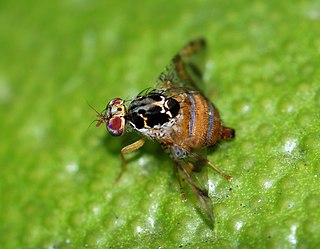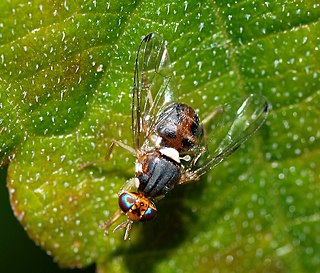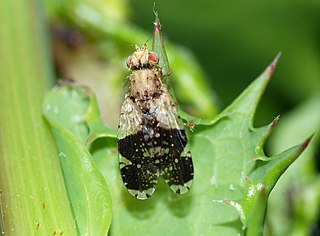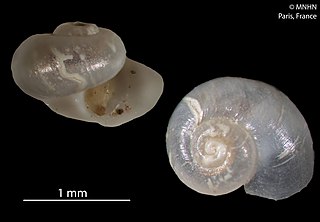
Dian Lake, also known as Dianchi, Dianchi Lake, Lake Dian and Kunming Lake, is a fault lake located on the Puduhe-Xishan fault in Kunming, Yunnan, China at 24°23′–26°22′ N, 102°10′–103°40′ E. Its nickname is the "Sparkling Pearl Embedded in a Highland". It is the model for the Kunming Lake in Beijing's Summer Palace. Its name is the source of Yunnan's Chinese abbreviation 滇.

The Tephritidae are one of two fly families referred to as fruit flies, the other family being the Drosophilidae. The family Tephritidae does not include the biological model organisms of the genus Drosophila, which is often called the "common fruit fly". Nearly 5,000 described species of tephritid fruit fly are categorized in almost 500 genera of the Tephritidae. Description, recategorization, and genetic analyses are constantly changing the taxonomy of this family. To distinguish them from the Drosophilidae, the Tephritidae are sometimes called peacock flies, in reference to their elaborate and colorful markings. The name comes from the Greek τεφρος, tephros, meaning "ash grey". They are found in all the biogeographic realms.

Bactrocera tryoni, the Queensland fruit fly, is a species of fly in the family Tephritidae in the insect order Diptera. B. tryoni is native to subtropical coastal Queensland and northern New South Wales. They are active during the day, but mate at night. B. tryoni lay their eggs in fruit. The larvae then hatch and proceed to consume the fruit, causing the fruit to decay and drop prematurely. B. tryoni are responsible for an estimated $28.5 million a year in damage to Australian crops and are the most costly horticultural pest in Australia. Up to 100% of exposed fruit can be destroyed due to an infestation of this fly species. Previously, pesticides were used to eliminate B. tryoni from damaging crops. However, these chemicals are now banned. Thus, experts devoted to B. tryoni control have transitioned to studying this pests' behaviors to determine a new method of elimination.

Ceratitis capitata, commonly known as the Mediterranean fruit fly or medfly, is a yellow-and-brown fly native to sub-Saharan Africa. It has no near relatives in the Western Hemisphere and is considered to be one of the most destructive fruit pests in the world. There have been occasional medfly infestations in California, Florida, and Texas that require extensive eradication efforts to prevent the fly from establishing itself in the United States.
Squalus grahami, the eastern longnose spurdog, is a dogfish of the family Squalidae, found off northern Queensland, at depths between 220 and 500 m. Its length is up to 64 cm. Its reproduction is ovoviviparous.

Ceratitis is a genus of tephritid fruit flies with about 80 species. One of the best known species is Ceratitis capitata, the Mediterranean fruit fly.

The Dacinae are a subfamily of the fruit fly family Tephritidae. Its 41 genera are distributed among three tribes:

Graham's frog – also known as the diskless-fingered odorous frog – is a species of frog in the family Ranidae. It is found in China and Vietnam. Presumably it is also found in Myanmar in areas adjacent to its Chinese distribution area.

The Rio Grande darter is a small species of ray-finned fish, a darter from the subfamily Etheostomatinae, part of the family Percidae which includes the perches, ruffs and pike-perches. It is endemic to the lower Rio Grande drainage of the United States and Mexico. It inhabits riffles over substrates of gravel or rubble. This species can reach a length of 6 cm (2.4 in), though most only reach about 3 cm (1.2 in). The Rio Grande darter was first formally described as Oligocephalus grahami in 1859 by the French zoologist Charles Frédéric Girard (1822-1895) with the type locality given as the Devils River in Texas. The specific name honors the American soldier and topographer James Duncan Graham (1795-1865), who led the expedition on which the type was collected by John H. Clark.

The Tephritid Workers Database is a web-based database for sharing information on tephritid fruit flies. Because these species are one of the most economically important group of insect species that threaten fruit and vegetable production and trade worldwide, a tremendous amount of information is made available each year: new technologies developed, new information on their biology and ecology; new control methods made available, new species identified, new outbreaks recorded and new operational control programmes launched. The TWD allows workers to keep up-to-date on the most recent developments and provides an easily accessible and always available resource.

Tephritis is a genus of flies. It contains around 170 described species, making it the sixth largest genus in the family Tephritidae. Many more undescribed species are known from specimen collections. Tephritis occur throughout much of the world, but most are Palearctic. They can be found in a wide range of climate types, from hot semidesert to tundra. Most species inhabit the inflorescences of plants from several tribes in the family Asteraceae, and a few species cause galls to form.

Xyloskenea grahami is a species of sea snail, a marine gastropod mollusk, unassigned in the superfamily Seguenzioidea.

Anolis grahami, commonly known as the Jamaican turquoise anole and Graham's anole, is a species of lizard in the family Dactyloidae. The species is native to the island of Jamaica, and has also been introduced to the territory of Bermuda. It is one of many different species of anole lizards found in Jamaica. There are two recognized subspecies.
Ceratitis rosa, or commonly known as the natal fruit fly, is a fruit fly species from the family Tephritidae of the order Diptera. It is considered a pest in both its native and non-native habitats. It prefers subtropical or temperate climates and the fruits that are native to these areas. It is also capable of surviving in less dry climates compared to its relative, the Ceratitis capitata which is more specific in its habitats, described by Anton Ferdinand Karsch in 1887 in Delagoa Bay, Mozambique. Not long after in 1900, the natal fruit fly was a recognized pest for orchards and fruit farmers throughout KwaZulu Natal Province, Republic of South Africa.
Ceratitis ovalis is a species of tephritid or fruit flies in the family Tephritidae. It is known from Sierra Leone.
Ceratitis flexuosa is a species from the kingdom Animalia, family Tephritidae. This is a genus of Tephritid or fruit flies.
Ceratitis penicillata is a species of fruit fly from the family Tephritidae.
Ceratitis podocarpi is a species of fruit flies in the family Tephritidae. It is a pest of various cultivated species of Cucurbitaceae, especially the pumpkin, squash and melon. Ceratitis podocarpi is found in almost all Southern African countries like Ethiopia, Kenya, South Africa.
Ceratitis aliena is a species of insect in the family Tephritidae. This is a genus of Tephritid or fruit flies.

Anastrepha fraterculus, known as the South American fruit fly, is a fruit fly species from the genus Anastrepha. A. fraterculus is a polyphagous, frugivorous fly that is a significant pest of commercial fruit production in South America.












